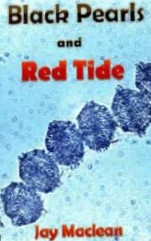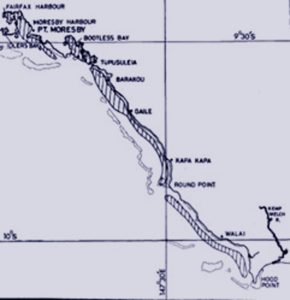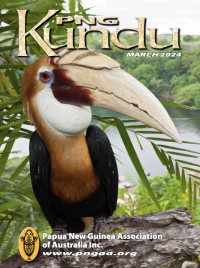Finding an Invisible Killer in PNG Waters
Jay Maclean
The strange deaths of three young children in a small coastal village in the Territory of Papua New Guinea in 1972 did not rate a mention in the Territory’s annual report to the Australian government. Yet, it was to become an event of international proportions. As a marine biologist seconded to the Territory government, I investigated the phenomenon during 1972–73 and continued my investigations for many years afterward, including co-organising an international conference on the subject. The cause was a microscopic marine algal species, never recorded in the western Pacific, and known elsewhere only as a harmless species Here, I describe the initial discovery and confirmation of the alga as the cause of the children’s deaths.
In early 1972, hospitals in the vicinity of Port Moresby began filling up with people suffering from symptoms not seen before in the area: tingling sensation in the lips, hyperactivity, ataxia, and mild convulsion and paralysis of the respiratory mechanism. In all, there were seven distinct episodes covering several adjacent villages during March to July 1972. It was an epidemic. In April, three young children died from the disease.
After the deaths, village residents began looking for ‘payback’, that is, revenge. When investigating doctors arrived in the affected village, the villagers were preparing for battle against residents of nearby villages, whom they suspected of having poisoned the water in their well. Residents of the other villages were blaming the government for contaminating their wells with DDT, which was being sprayed in an effort to kill mosquitoes to reduce the widespread incidence of malaria in the area.
No one could provide an answer that would placate the villagers; the illnesses had no precedent. Fortunately, they were persuaded to wait for government agencies to find the cause before they slaughtered one another indiscriminately. The prospect of bloodshed remained a threat however, and an answer would have to be found fast. The well water was quickly determined to be clean and devoid of pesticide.
The patients’ symptoms were not of simple food poisoning. Shellfish were the main component of the victims’ last meal and Health Department doctors determined that all who died or became ill ate shellfish. But then again, shellfish were always a prominent part of their diet. Some had eaten oysters and others had eaten various kinds of clams. Some ate them fresh; others boiled them first.
There were few possible causes of the deaths, if indeed they were from eating shellfish: shellfish poisoning is either from eating some that have ‘gone off,’ or an individual allergic response, or paralytic shellfish poisoning (PSP), caused by the shellfish feeding on a kind of alga in the sea that is harmless to the shellfish but potentially fatal to humans.
A call for help in solving the mystery arrived at the government marine research station in Kanudi, in Port Moresby Harbour. As the shellfish ‘expert’ at the time, I joined a team of chemists—Mal Price and Greg Worth—and a neurosurgeon, Frank Rhodes.
One of the joys of working in the Territory was the speed at which decisions could be made and action taken. The bureaucratic red tape one normally associates with any government-led undertaking was simply absent. Our team was not appointed, let alone given terms of reference or a chain of command. The four of us had a preliminary meeting, at which we concluded that the most probable cause of illness was PSP and discussed how we could verify or discount that conclusion.
We felt like, indeed we were, detectives. The clues to the mystery might seem obvious now, but in the still-remote tropics in the early 1970s, they were as obscure as any faced by Sherlock Holmes.
Immediately after the meeting, Frank called for all the patients’ case histories, the chemists sent for mice, and I called for a helicopter.
Frank wrote a clinical description of the cases for the Papua New Guinea Medical Journal. The symptoms were those of PSP. Patients who survive 12 hours usually recover, as did all the adult patients in the present epidemic.
The standard method of measuring PSP at the time was to inject finely ground solutions of tissues from the shellfish (and later we extended this to the plankton) into live mice, a practice that has long since given way to chemical analyses. The chemists were lucky enough to find some mice being bred for other purposes in the Health Department. However, there was no standard toxin available to use as a reference to quantify the strength of any toxin.
Nevertheless, the results were quite conclusive. Mouse toxicity was rated on an arbitrary three-point scale. An average death time of mice of less than seven minutes was regarded as toxic; death times between seven and 20 minutes were regarded as representing mild toxicity; while mice surviving longer than 20 minutes did not subsequently die, indicating no toxicity. Shellfish taken from meal leftovers in the affected villages, either raw or boiled, proved to be toxic or mildly toxic in all cases. In most, the mice died in less than one minute—it was a powerful poison! The toxin was found to be confined to bivalve shellfish, like clams and oysters.
Meanwhile, I was aloft in a yellow Dragonfly helicopter. Being new to helicopters of any size, I was absolutely thrilled and heedless of the danger as we clattered low over stretches of beach and up over headlands between them; children and adults waving as we passed. If PSP was the answer to the poisonings, it was caused by a red tide, in which areas of the sea turn a rusty red due to high concentrations of the causative organism at the surface. Sure enough, I began to spot reddish streaks right outside Port Moresby Harbour and along the 80-kilometre stretch of coast where the affected villages lay.
We had our red tide but still it could have been a harmless type. The red tide that gave the Red Sea its name, for example, is due to a harmless algal species, red tides of which are common in the tropical Pacific.
The next step, then, was to take water samples. Rushing straight from the helicopter, I managed to rent a speedboat and driver, grabbed some collecting gear and headed for the site. The trip was awful to say the least. The daily monsoonal wind had come up and generated a sickening swell. When we arrived in the area, red tide was nowhere to be found. The view from the sea surface was of the next few crests and the swell was probably dispersing any colouration. Nevertheless, I took some seawater samples and when I examined them under a microscope back at Kanudi, I found one single-cell algal species dominating the samples.
This was promising but I had to get samples from a visible red tide to make sure it was composed of the same tiny cells. However, finding red tides from surface vessels was going to be a needle in a haystack business. Aerial support would be necessary, so why not take samples using the helicopter and avoid the surface vessels altogether?
Early next day, I was in the Dragonfly hovering over a dense red tide outside Port Moresby Harbour. For sampling, I had a Nansen bottle, the standard tool for seawater sampling. It was a heavy tube of brass and was lowered down a wire while open at both ends. When it reached the desired depth, a heavy messenger weight was sent down the wire that tripped a spring that closed both ends and secured exactly one litre of seawater. In the laboratory, one filtered off all the seawater and identified and counted the organisms left behind.
Both the pilot and I were rather nervous about balancing the helicopter a few metres above the sea in one spot while the sampling was done. I thought the bubble-like machine might float and asked the pilot. ‘Yeah, like a streamlined manhole cover,’ he shouted. He was sweating at the controls and calling to me over the noise of the whirring blades to hurry. I had to lean out into space with one foot hooked behind the seat, dangling the heavy equipment over the red tide. In this awkward position I managed to take a few samples before the pilot became overwrought, and suddenly took us almost violently upward, shouting ‘That’s enough’.
Back in my Kanudi laboratory, I placed a drop of these precious samples on a slide under a high-power microscope. I was amazed to see huge numbers of orange-brown coloured algae actively swimming around the field of view. It was a planktonic red tide all right, the same beast I captured from the speedboat.
But what were they? Photos of known red tide organisms in the available books and reports did not quite resemble it, although it was clearly closely related to known producers of paralytic shellfish toxin.
I rushed some of this live material over to the chemistry laboratory in Konedobu to see how the mice would react to a direct injection of this organism. We watched as the hapless mice were injected and replaced in their cages. The seconds passed and then a minute and then five minutes. Nothing happened. The mice recovered and were quietly sniffing around their new quarters.
This was a major setback. If these algae were not the killers, we were back to square one in the puzzle. Yet, there was nowhere left to look unless all the other clues were wrong as well.
Small as they were, about 5–6 hundredths of a millimetre in diameter, these red tide algae had a rugged-looking shell. From my undergraduate biology lectures, I remembered that shellfish, most of which eat whatever small planktonic algae come within reach, suck them in through their gills and pass them to the stomach via a kind of mortar and pestle, which breaks up the plankton for digestion. We needed to simulate this action to see if we could find and release any poison in the red tide organism.
The chemistry lab had a sonic disintegrator, a metal cylinder that produced sound waves to break up tough matter, like the cell walls on these algae. I was amazed that the Territory was in possession of such modern equipment and drove at high speed to the laboratory with some of the sample material. There was no time to lose, as the cells could not live long in their concentrated state.
I hid my emotions as I tipped some of the helicopter’s sample into the cylinder. The result was an orange liquid and, the microscope revealed a mass of tiny broken pieces of shell. The liquid was injected into the hapless mice and they died—very, very rapidly. We had our culprit.
Subsamples of the red tide were preserved in small vials, sealed, and sent to plankton experts overseas. Our killer turned out to be a single-celled alga called Pyrodinium bahamense, first described in Jamaica, where it produced harmless red tides that glowed at night.
 The event in PNG was found to be associated with the first major El Niño phenomenon in 50 years. In subsequent El Niño periods, outbreaks spread northward to Brunei, Darussalam, Sabah and, by 1983, the Philippines.
The event in PNG was found to be associated with the first major El Niño phenomenon in 50 years. In subsequent El Niño periods, outbreaks spread northward to Brunei, Darussalam, Sabah and, by 1983, the Philippines.
Editor’s Note: This article is from the book, Black Pearls and Red Tides, 2018, available on Amazon and other major eBook retailers. The book describes Jay Maclean’s research into red tides as well as oyster and pearl oyster culture in PNG and his subsequent investigations into the nature and spreading of the red tide.




